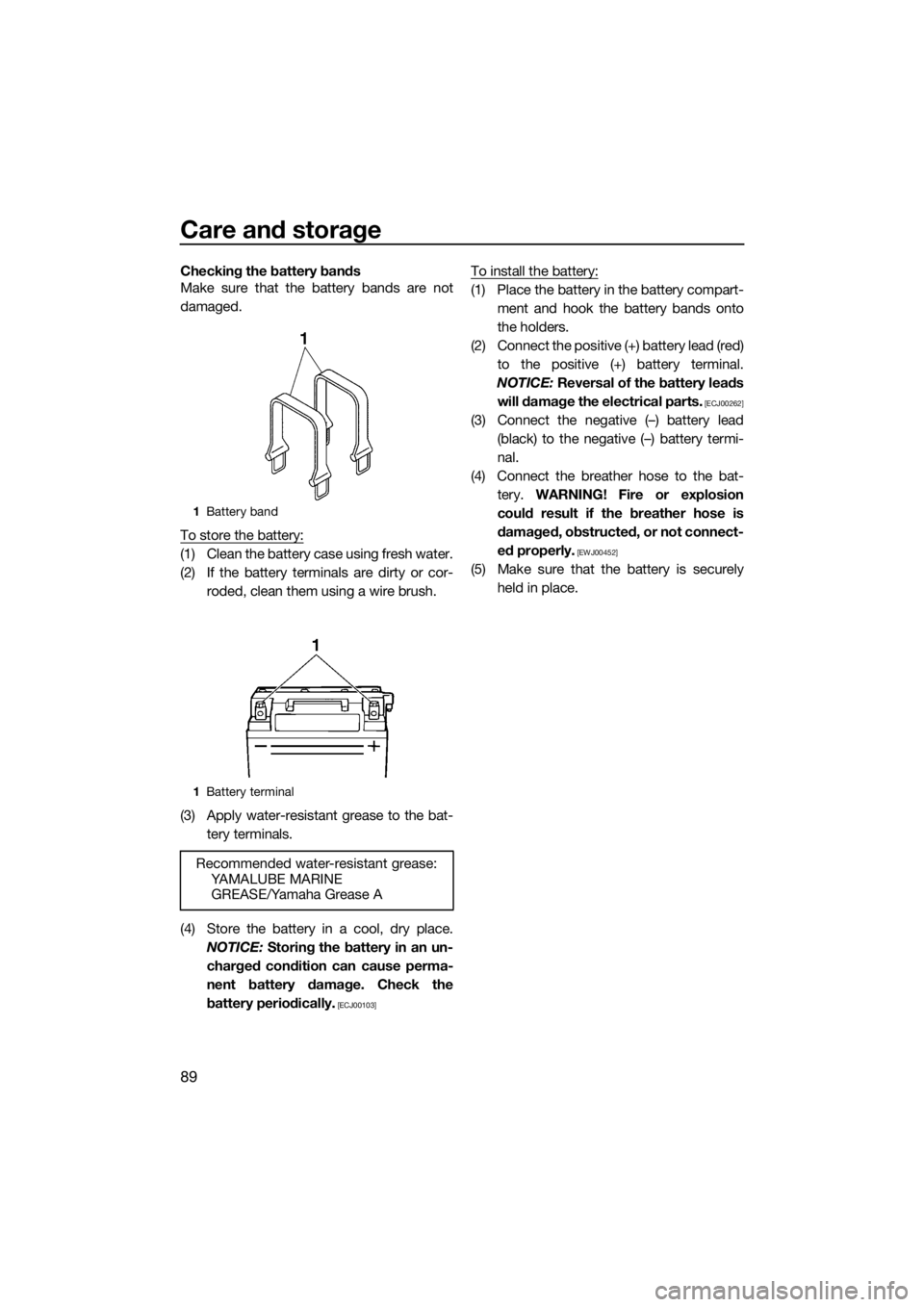2020 YAMAHA FX HO CRUISER warning
[x] Cancel search: warningPage 94 of 116

Care and storage
87
ter flows out continually from the jet
thrust nozzle.
(8) Run the engine at idling speed for about
3 minutes watching the engine condition.
If the engine stops while flushing, turn
the water supply off immediately and
perform the procedure again from step 7.
NOTICE: Do not supply water to the
cooling water passages when the en-
gine is not running. The water could
flow back through the muffler into the
engine, causing severe engine dam-
age.
[ECJ00123]
(9) Turn the water supply off.
(10) Discharge the remaining water out of the
cooling water passages by alternately
squeezing and releasing the throttle lever
quickly for 10 to 15 seconds.
(11) Stop the engine.
(12) Remove the garden hose adapter, and
then securely install the flushing hose
connector cap by tightening it until it
stops.
(13) Securely close the stern storage com-
partment.
(14) Securely install the removable watertight
storage compartment and seats in their
original positions.
EJU33736Cleaning the watercraft
(1) Remove the seats. (See page 49 for seat
removal and installation procedures.)(2) Rinse the engine and engine compart-
ment with a small amount of water.
NOTICE: Do not use high-pressure
water when rinsing the engine or en-
gine compartment as severe engine
damage could result.
[ECJ00572]
(3) Drain the water from the engine com-
partment. (See page 61 for information
on draining the bilge water.)
(4) Wipe the engine and engine compart-
ment with a dry cloth.
(5) Wash down the hull, deck, and jet pump
with fresh water.
(6) Wipe the hull, deck, and jet pump with a
dry cloth.
(7) Wipe all vinyl and rubber components,
such as the seats and engine compart-
ment seals, with a vinyl protectant.
(8) To minimize corrosion, spray metallic
parts of the hull, deck, and engine with a
rust inhibitor.
(9) Allow the engine compartment to air dry
completely before installing the seats.
(10) Securely install the seats in their original
positions.
EJU33688Battery care
If the watercraft will not be used for more than
a month, remove the battery from the water-
craft, check it, and then store it in a cool, dry
place.
WARNING
EWJ00792
Battery electrolyte is poisonous and dan-
gerous, causing severe burns, etc. Elec-
trolyte contains sulfuric acid. Avoid
contact with skin, eyes, or clothing.
Antidotes
External: Flush with water.
Internal: Drink large quantities of water or
milk. Follow with milk of magnesia, beaten
UF3V71E0.book Page 87 Tuesday, June 25, 2019 9:14 AM
Page 96 of 116

Care and storage
89
Checking the battery bands
Make sure that the battery bands are not
damaged.
To store the battery:
(1) Clean the battery case using fresh water.
(2) If the battery terminals are dirty or cor-
roded, clean them using a wire brush.
(3) Apply water-resistant grease to the bat-
tery terminals.
(4) Store the battery in a cool, dry place.
NOTICE: Storing the battery in an un-
charged condition can cause perma-
nent battery damage. Check the
battery periodically.
[ECJ00103]
To install the battery:
(1) Place the battery in the battery compart-
ment and hook the battery bands onto
the holders.
(2) Connect the positive (+) battery lead (red)
to the positive (+) battery terminal.
NOTICE: Reversal of the battery leads
will damage the electrical parts.
[ECJ00262]
(3) Connect the negative (–) battery lead
(black) to the negative (–) battery termi-
nal.
(4) Connect the breather hose to the bat-
tery. WARNING! Fire or explosion
could result if the breather hose is
damaged, obstructed, or not connect-
ed properly.
[EWJ00452]
(5) Make sure that the battery is securely
held in place.
1Battery band
1Battery terminal
Recommended water-resistant grease:
YAMALUBE MARINE
GREASE/Yamaha Grease A
UF3V71E0.book Page 89 Tuesday, June 25, 2019 9:14 AM
Page 97 of 116

Care and storage
90
EJU33493
Long-term storage
WARNING
EWJ00331
Always place the watercraft upright in a
horizontal position when storing it, other-
wise fuel could leak out into the engine or
engine compartment, which could create
a fire hazard.
Storage for long periods of time, such as win-
ter storage, requires preventive maintenance
to ensure against deterioration. It is advisable
to have the watercraft serviced by a Yamaha
dealer prior to storage.
However, the following procedures can be
performed easily by the owner.
EJU40763Cleaning
(1) Flush the cooling water passages. (See
page 86 for information on flushing the
cooling water passages.)
TIP:
If you will be storing the watercraft for a pro-
longed period, such as winter storage, top off
the fuel tank with fresh gasoline and add fuel
stabilizer and conditioner to the fuel tank ac-
cording to the manufacturer’s instruction be-
fore starting the engine.
(2) Clean the watercraft. (See page 87 for in-
formation on cleaning the watercraft.)
Wax the hull with a non-abrasive wax.
EJU44741Lubrication
To keep moving parts sliding or rotating
smoothly, lubricate them with water-resistant
grease.
Steering cable (jet thrust nozzle end), elec-
tric trim rod (jet thrust nozzle end), and ball
joint
TIP:
Disconnect the electric trim rod from the ball
joint before lubricating.
Shift rod (reverse gate end) and ball joint
TIP:
Disconnect the shift rod from the ball joint be-
fore lubricating.
EJU40812Rustproofing
Spray metallic parts of the hull, deck, and en-
gine with a rust inhibitor.
Have a Yamaha dealer rustproof the internal
engine components.
Recommended water-resistant grease:
YAMALUBE MARINE GREASE /
Ya m a h a G r e a s e A
UF3V71E0.book Page 90 Tuesday, June 25, 2019 9:14 AM
Page 98 of 116

Maintenance
91
EJU33769
Maintenance
Periodic checks and lubrication will keep
your watercraft in the safest and most effi-
cient condition possible. Therefore, make
sure to carry out the periodic maintenance.
Safety is an obligation of the watercraft own-
er. Proper maintenance must be carried out
to keep the exhaust emission and sound lev-
els within the regulated limits. The most im-
portant points of watercraft inspection and
lubrication are explained on the following pa-
ges.
See a Yamaha dealer for genuine Yamaha re-
placement parts and optional accessories
designed for your watercraft.
Remember, failures that are the result of the
installation of parts or accessories which are
not qualitatively equivalent to genuine
Yamaha parts are not covered by the limited
warranty.
Maintenance, replacement, or repair of
the emission control devices and system
may be performed by any marine SI engine
repair establishment or individual. War-
ranty repair, however, must be performed
at an authorized Yamaha marine dealer-
ship.
WARNING
EWJ00312
Be sure to turn off the engine when you
perform maintenance unless otherwise
specified. If you are not familiar with ma-
chine servicing, this work should be done
by a Yamaha dealer or other qualified me-
chanic.
EJU42023Removing and installing the engine
cover
The engine cover is removable.To remove the engine cover:
(1) Remove the seats. (See page 49 for seat
removal and installation procedures.)
(2) Remove the engine cover screws.
(3) Lift up the engine cover to remove it.
To install the engine cover:
(1) Place the engine cover in its original po-
sition, and then push it down.
(2) Install the engine cover screws.
1Engine cover screw
1Engine cover
1
1
UF3V71E0.book Page 91 Tuesday, June 25, 2019 9:14 AM
Page 102 of 116

Maintenance
95
EJU36943Engine oil and oil filter
WARNING
EWJ00341
Engine oil is extremely hot immediately af-
ter the engine is turned off. Coming in con-
tact with or getting any engine oil on your
clothes could result in burns.
NOTICE
ECJ00992
Do not run the engine with too much or not
enough oil in the engine, otherwise the en-
gine could be damaged.
It is recommended to have a Yamaha dealer
change the engine oil and the engine oil filter.
However, if you choose to change the oil and
filter on your own, consult a Yamaha dealer.
UF3V71E0.book Page 95 Tuesday, June 25, 2019 9:14 AM
Page 105 of 116

Trouble recovery
98
Engine runs irregu-
larly or stallsFuel Fuel tank empty Refill as soon as pos-
sible57
Stale or contaminat-
edHave serviced by
Yamaha dealer—
Fuel tank Water or dirt present Have serviced by
Yamaha dealer—
Spark plug Fouled or defective Have serviced by
Yamaha dealer—
Incorrect heat range Have serviced by
Yamaha dealer—
Gap incorrect Have serviced by
Yamaha dealer—
Electrical wir-
ingLoose connection Have serviced by
Yamaha dealer—
Fuel injec-
tion systemFaulty or clogged in-
jectorsHave serviced by
Yamaha dealer—
Warning is dis-
playedFuel level
warningFuel tank empty Refill as soon as pos-
sible57
Oil pressure
warningOil pressure dropped Have serviced by
Yamaha dealer48
Engine over-
heat warningJet intake clogged Clean
100
Check en-
gine warningFaulty sensors Have serviced by
Yamaha dealer47 TROUBLE POSSIBLE CAUSE REMEDY PAGE
UF3V71E0.book Page 98 Tuesday, June 25, 2019 9:14 AM
Page 106 of 116

Trouble recovery
99
Watercraft slow or
loses powerWatercraft
operation
modeDrive control mode
activatedDeactivate or adjust
drive control mode 36
Cavitation Jet intake clogged Clean 100
Impeller damaged or
wornHave serviced by
Yamaha dealer100
Engine over-
heat warningEngine speed reduc-
tion control activatedClean jet intake and
cool engine47
Oil pressure
warningEngine speed reduc-
tion control activatedAdd oil
48
Spark plug Fouled or defective Have serviced by
Yamaha dealer—
Incorrect heat range Have serviced by
Yamaha dealer—
Gap incorrect Have serviced by
Yamaha dealer—
Electrical wir-
ingLoose connection Have serviced by
Yamaha dealer—
Fuel Stale or contaminat-
edHave serviced by
Yamaha dealer—
Air filter Clogged Have serviced by
Yamaha dealer—
Oil buildup Have serviced by
Yamaha dealer—
Throttle lever Faulty Have serviced by
Yamaha dealer— TROUBLE POSSIBLE CAUSE REMEDY PAGE
UF3V71E0.book Page 99 Tuesday, June 25, 2019 9:14 AM
Page 107 of 116

Trouble recovery
100
EJU34625
Emergency proceduresEJU44590Cleaning the jet intake and impeller
WARNING
EWJ00783
Before attempting to remove weeds or de-
bris from the jet intake or impeller area,
shut the engine off and remove the clip
from the engine shut-off switch. Severe in-
jury or death could result from coming in
contact with the rotating parts of the jet
pump.
If weeds or debris gets caught in the jet intake
or impeller, cavitation can occur, causing jet
thrust to decrease even though engine speed
rises. If this condition is allowed to continue,
the engine will overheat and may seize.
NOTICE: If weeds or debris gets caught in
the jet intake, do not operate the water-
craft above trolling speed until they have
been removed.
[ECJ00654]
If there is any sign that the jet intake or impel-
ler is clogged with weeds or debris, return to
shore and check the intake and impeller. Al-ways stop the engine before beaching the
watercraft.
(1) Place a suitable clean cloth or carpeting
underneath the watercraft to protect it
from abrasions and scratches. Turn the
watercraft on its side as shown.
NOTICE: When turning the watercraft
on its side, support the bow so that
the handlebars are not bent or dam-
aged.
[ECJ02690]
(2) Remove any weeds or debris from
around the jet intake, drive shaft, impel-
UF3V71E0.book Page 100 Tuesday, June 25, 2019 9:14 AM